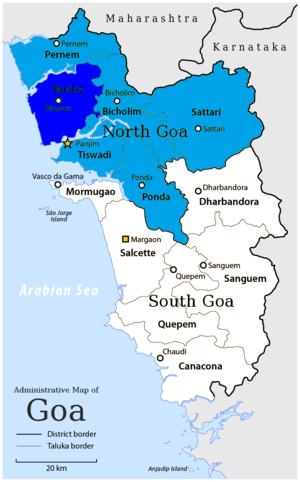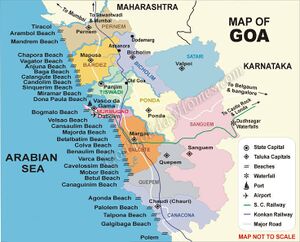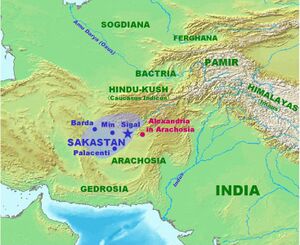Bardez
| Author:Laxman Burdak, IFS (R) |
Bardez (बारदेज़) is a region and taluka situated in the northern portion of the state of Goa, India, in the district of North Goa. A native of Bardez is called a Bardezcar in the local Konkani language.
Contents
Variants
Location
Bardez is delimited on the north by the Chapora River, on the south by the Mandovi River, on the east by the Mapusa River, which originates in Bardez itself near the capital city of Mapusa, and on the west by the Arabian Sea.
Origin
According to an oral source Bardez gets name from Bara (twelve) desh (country), means 'twelve countries' (or territories).
Jat clans
History
The name is credited to the Saraswat Brahmin immigrants who emigrated to the Konkan coast via Magadha plains in northern India. Bardez, or more properly Bara (twelve) desh (country), means 'twelve countries' (or territories). The form 'country' probably refers to clan territorial limits. These twelve villages are: 1. Aldona, 2. Anjuna, 3. Assagao, 4. Candolim, 5. Moira, 6. Nachinola, 7. Olaulim, 8. Pomburpa, 9. Saligao, 10. Sangolda, 11. Serula, 12. Siolim.
Barda City
This tradition of people coming from Magadha plains is not supported by any evidence and seems improbable. Normal route of people coming to this region on western sea cost is from Sindh (Pakistan) or Iran. It is probable that people from Barda City came to the region and gave the name to this place based on their parent city Barda which corrupted to Bardez. If this is correct then it is associated with Burdak history as well. Probably a branch of Burdaks moved from Iran to this region. Let us know about Barda City.
Barda City was in Sistan along with Min and Sigal in 1st BCE., the place was the royal residence of the Sakas in Sistan.
Parthian Stations by Isidore of Charax, is an account of the overland trade route between the Levant and India, in the 1st century BCE, The Greek text with a translation and commentary by Wilfred H. Schoff. Transcribed from the Original London Edition, 1914. This record mentions about city named Barda. Burdaks are probably originated from city called Barda, the place is the royal residence of the Sakas in Sistan. The presence of the Sakas in Sakastan in the 1st century BCE is mentioned by Isidore of Charax in his "Parthian stations". He explained that they were bordered at that time by Greek cities to the east (Alexandria of the Caucasus and Alexandria of the Arachosians), and the Parthian-controlled territory of Arachosia to the south:
- "Beyond is Sacastana of the Scythian Sacae, which is also Paraetacena, 63 schoeni. There are the city of Barda and the city of Min and the city of Palacenti and the city of Sigal (Cf. Nimrus of the Rustam story in the Shah Nama); in that place is the royal residence of the Sacae; and nearby is the city of Alexandria (and nearby is the city of Alexandropolis), and six villages." Parthian stations, 18.[1]
Beyond is Arachosia, 36 schoeni. And the Parthians call this White India; there are the city of Biyt and the city of Pharsana and the city of Chorochoad and the city of Demetrias; then Alexandropolis, the metropolis of Arachosia; it is Greek, and by it flows the river Arachotus. As far as this place the land is under the rule of the Parthians." Parthian stations, 19.[2]
Notable places
Bardez is the site of the legislature of Goa, in the southern parish village of Penha de França (Britona), in Serula. Other famous sites are the Fort Aguada, the beaches of Candolim, Sinquerim, Calangute, Baga, Anjuna, and Vagator villages, the hilltop monastery and boarding school of Monte Guirim, which was restored by Padre Luna after Pombal's devastation, the village communities of Salvador do Mundo, Penha da França, Siolim, Moira, Porvorim, Colvale, Saligao, and Sangolda, to name but the most prominent.
Goa's Indian Institute of Hotel Management (IIHM) and Saint Xavier's College, Mapusa are located in Bardez.
The village and comunidade of Anjuna was famous as a hippie settlement. Among the Goan Catholics, it is famous as the birthplace of Venerable Father Agnelo, who is expected to attain sainthood. He is one of the two most prominent Catholic religious Goan, the other being St. Saint Joseph Vaz, the 'Apostle of Ceylon', who attained sainthood recently.
List of Villages in Bardez tahsil
1. Aldona, 2. Anjuna, 3. Arpora, 4. Assagao, 5. Assonora, 6. Bastora, 7. Calangute, 8. Calvim, 9. Camurlim, 10. Canca, 11. Candolim, 12. Colvale, 13. Corjuem, 14. Guirim, 15. Marna, 16. Marra, 17. Moira, 18. Moitem, 19. Nachinola, 20. Nadora, 21. Nagoa, 22. Nerul, 23. Olaulim, 24. Oxel, 25. Paliem, 26. Parra, 27. Penha De Franca, 28. Pilerne, 29. Pirna, 30. Pomburpa, 31. Ponolem, 32. Punola, 33. Reis Magos, 34. Revora, 35. Saligao, 36. Salvador Do Mundo, 37. Sangolda, 38. Siolim, 39. Sircaim, 40. Socorro, 41. Tivim, 42. Ucassaim, 43. Verla,
बारदेज़ परिचय
बारदेज़ (कोंकणी: बार्देस), उत्तर गोवा जिले का एक तालुक है। इस तालुक का मुख्यालय मापुसा शहर है। संभवत: बारदेज़ का नाम मगध से प्रवासित ब्राह्मणों ने यहां के बारह गांवों (अल्दोना, मोइरा, ओलौलिम, नचिनोला, सिओलिम, अंजुना, कैंडोलिम, सेरूल, सलिगाओ, सैंगोल्डा, असागाओ और पोम्बुर्पा) की संख्या के आधार पर बारह-देश रखा था जिसे पुर्तगालियों ने बारदेज़ कर दिया।
बारदेज़ की सीमायें, पूर्व में मापुसा नदी, पश्चिम में अरब सागर, उत्तर में चपोरा नदी और दक्षिण में मांडवी नदी द्वारा निर्धारित होती हैं।



